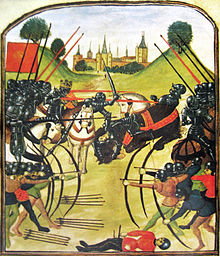 Global Information
Global InformationWars of the Roses information
| Wars of the Roses | |||||||
|---|---|---|---|---|---|---|---|
 Miniature of the Battle of Tewkesbury, late 15th century | |||||||
| |||||||
| Belligerents | |||||||
|
| ||||||
| Commanders and leaders | |||||||
|
| ||||||
| Casualties and losses | |||||||
| 105,000 dead[1] | |||||||
The Wars of the Roses, known at the time and in following centuries as the Civil Wars, were a series of civil wars fought over control of the English throne from 1455 to 1487. The wars were fought between supporters of the House of Lancaster and House of York, two rival cadet branches of the royal House of Plantagenet. The conflict resulted in the end of Lancaster's male line in 1471, enabling the Tudor family to inherit their claim to the throne through the female line. Conflict was largely brought to an end upon the union of the two houses through marriage, creating the Tudor dynasty that would subsequently rule England.
The Wars of the Roses were rooted in English socio-economic troubles caused by the Hundred Years' War (1337–1453) with France, as well as the quasi-military bastard feudalism resulting from the powerful duchies created by King Edward III. The mental instability of King Henry VI revived Richard, Duke of York's interest in a claim to the throne. Warfare began in 1455 with York's capture of Henry at the First Battle of St Albans, upon which York was appointed Lord Protector by Parliament. Fighting resumed four years later when Yorkists led by Richard Neville, Earl of Warwick captured Henry again at the Battle of Northampton. After attempting to seize the throne, York was killed at the Battle of Wakefield, and his son Edward inherited his claim per the controversial Act of Accord. The Yorkists lost custody of Henry in 1461 after the Second Battle of St Albans, but defeated the Lancastrians at the Battle of Towton. Edward was formally crowned in June 1461.
In 1464, Edward married Elizabeth Woodville against the advice of Warwick, and reversed Warwick's policy of seeking closer ties with France. Warwick rebelled against Edward in 1469, leading to Edward's imprisonment after Warwick's supporters defeated a Yorkist army at the Battle of Edgcote. Edward was allowed to resume his rule after Warwick failed to replace him with his brother George of Clarence. Within a year, Warwick launched an invasion of England alongside Henry VI's wife Margaret of Anjou. Edward fled to Flanders, and Henry VI was restored as king in 1470. Edward mounted a counter-invasion with aid from Burgundy a few months later, and killed Warwick at the Battle of Barnet. Henry was returned to prison, and his sole heir later killed by Edward at the Battle of Tewkesbury, followed by Henry's own death in the Tower of London, possibly on Edward's orders. Edward ruled unopposed for the next twelve years, during which England enjoyed a period of relative peace. Upon his death in April 1483, he was succeeded by the twelve-year-old Edward V, who reigned for 78 days until being deposed by his uncle Richard III.
Richard assumed the throne amid controversies regarding the disappearance of Edward IV's two sons. He was met with a short-lived but major revolt and a wave of Yorkist defections. Amid the chaos, Henry Tudor, a descendant of Edward III through Lady Margaret Beaufort, returned from exile with an army and killed Richard at Bosworth Field in 1485. He then assumed the English throne as Henry VII and united the rival houses through marriage with Elizabeth of York, Edward IV's eldest daughter and heir. The wars concluded in 1487, with Henry VII's defeat of the remaining Yorkist opposition at Stoke Field. The House of Tudor would rule England until 1603, a period that saw the strengthening of the monarchy and the end of the medieval period in England.
Cite error: There are <ref group=lower-alpha> tags or {{efn}} templates on this page, but the references will not show without a {{reflist|group=lower-alpha}} template or {{notelist}} template (see the help page).
- ^ Clodfelter 2017, p. 51.